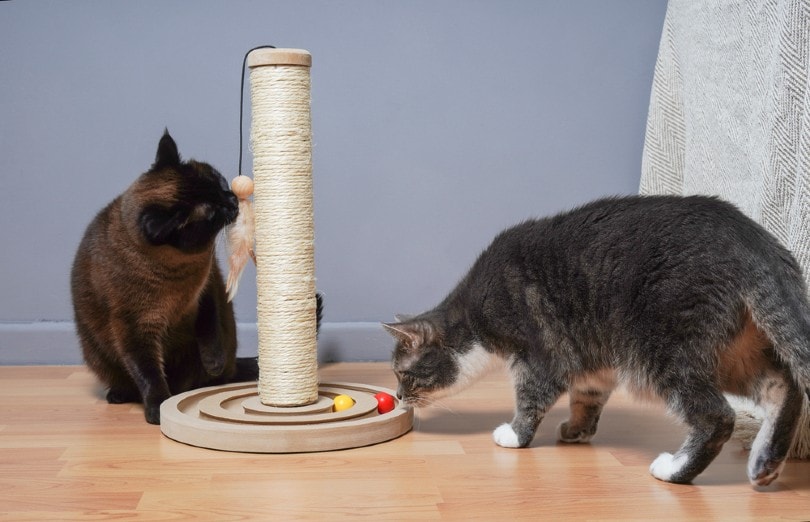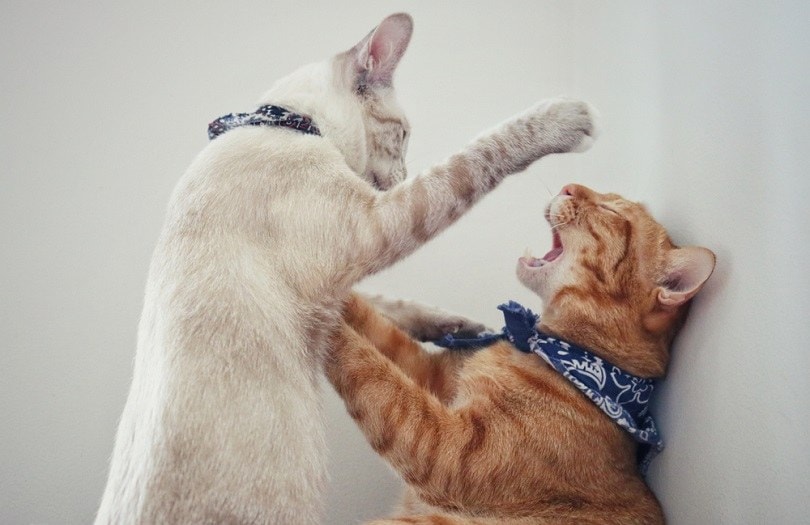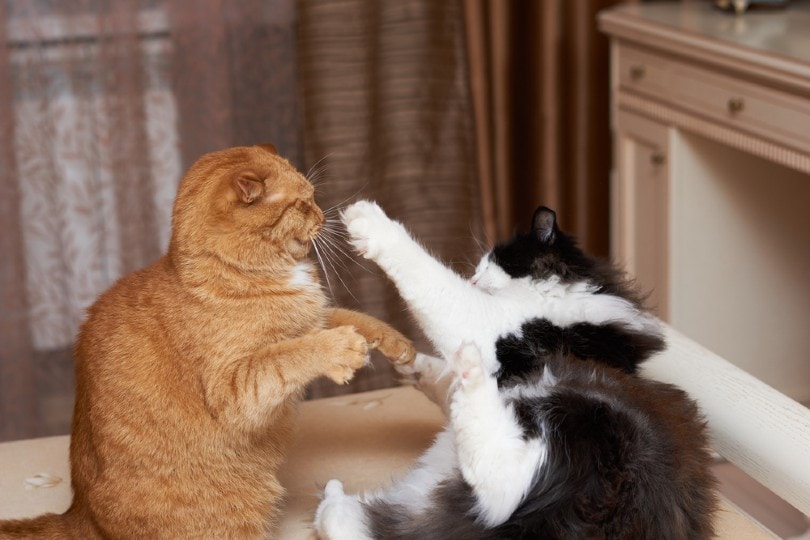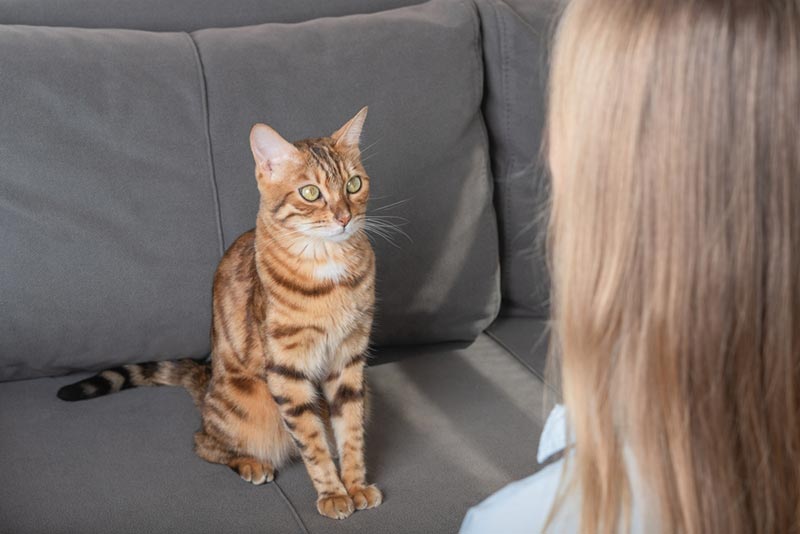VET APPROVED

The information is current and up-to-date in accordance with the latest veterinarian research.
Learn more »Click to Skip Ahead
As much as you may like to have more than one cat inside your home, most cats don’t like having other cats in their territory. On average, it takes most cats several months to get along and become friends, though some cats never get along.
A variety of factors can impact how long it takes for cats to get along. For example, how you introduce the two cats, and how they were socialized during kittenhood matters a lot.
To learn more about getting two cats to get along in your home, keep reading. This article covers how long it can take for cats to get along, why some cats never get along, and how to introduce your cat to new ones for the best results.
 How Long Does It Take for Two Cats to Get Along?
How Long Does It Take for Two Cats to Get Along?
As we learned above, it takes an average of several months for two cats to get along, but this time can change based on several factors. Cat gender can be one of these factors. By considering the cat’s gender, you will have a better idea of how long it may take for the cats to get along.

How Long Does It Take for Male Cats to Get Along?
Science doesn’t have a clear answer for this because different studies have shown various results. It seems that aggression between two unneutered males might be the most common form of inter-cat aggression, meaning that two intact male cats take much longer to get along. Luckily, neutering reduces this type of behavior in approximately 90% of the cases.
The reason why it takes male cats longer to get along is that males are often solitary in the wild and they don’t tend to form affiliative relationships as some females do, although they can live in small colonies if there are enough food sources. Because this is their natural behavior, house male cats often act the same way.
How Long Does It Take for Female Cats to Get Along?
In comparison to males, many females and kittens can form cooperative groups and live together in the wild, which explains why females don’t take as long to get along. Most females can get along within weeks or months, though some females may take shorter or longer.
It makes sense why females get along better with other cats than males. Unlike males, females help to raise kittens and spend part of their lives with other cats. Because of this practice, it is easier for females to adjust to other cats simply because their nature has evolved in such a way.
That being said, female cats that live in colonies are often related to the cats around them. Hence, the cats all grew up with one another. So, female cats are still territorial and not used to living with cats they aren’t related to or already familiar with.

Other Factors to Consider
In addition to gender, the age of the cats, whether they are fixed, if they had successful socialization, and individual personalities will impact how long it takes for cats to get along.
Cats that were raised together as kittens don’t take months to get along since they have been together since birth. Typically, the younger the cat is, the quicker they will likely get along with other cats. In contrast, many old cats do not like being introduced to new cats.
Whether or not your cat is fixed will hugely impact how they behave around other cats. Cats that are fixed often get along with other cats easily because they don’t have the hormonal influence that determines territorial instincts. Getting a cat fixed will help them get along with other cats.
Lastly, the individual personality of your cat will impact how they behave around other felines. Just like humans, certain cats are more antisocial than others. Some cats may be open to getting new friends, whereas others may prefer a more solitary lifestyle.

Why Don’t All Cats Get Along?
Unfortunately, some cats will simply not ever get along. Unlike humans and dogs, cats are primarily solitary in the wild. Because of this fact, house cats aren’t as open to living with other individuals as dogs are.
Even female cats that spend part of their life with other cats and kittens may not enjoy being around cats their entire life. Cats need a whole lot of space and room to be by themselves. If there are too many cats, the cat may begin to feel overwhelmed and without adequate space, leading to behavioral problems.

Signs Cats Don’t Get Along
There are some signs you can look out for to determine if cats are not getting along. Any obvious signs of aggression show that cats do not get along, such as chasing, biting, swatting, or outright fighting. Some more subtle signs that cats don’t get along include squatting or flattening their ears.
Often, squatting, flattening ears, and hissing are precursors to fighting. Once the cats fight, it is unlikely that they will ever get along.
If you need guidance on introducing your cats to each other, we suggest you speak to a vet or professional trainer.
How to Introduce Your Cat to New Cats
Just as with humans, first impressions matter a lot with cats. Getting the introduction fine and not rushing the process can be a big difference on how cats will get along with each other. If two cats fight outright on site, it is unlikely that they will ever get along because the cats will associate one another with fighting and territorial behavior. By introducing the cats to one another in a careful manner, you give your cats the best chance possible of getting along in the future.
1. Introduce the Smell and Sound of the Other Cat
The first thing you should do is introduce the cats to one another in a way so that the cats can only smell and hear one another. It is important that the cats don’t see each other right off the bat. By introducing the smell and sound of the other cat, the cats get to learn important information about one another without the situation escalating at all.
For example, keep the two cats on either side of the door. This allows the cats to smell and hear one another without seeing each other. To further ease introductions, exchange items like blankets or toys between the two cats for scent swapping. This helps them gradually get used to each other’s scent. For best results, change up the location over a series of days until the cats don’t seem to respond to one another.
2. Allow the Cats to See One Another Through a Gate
Once the two cats have adjusted to the smell and sound of the other without any signs of aggression, you can take things to the next level. Allow the two cats to finally see one another for a very short period of time. Make sure there is still a gate between the two so that there are no fights.
During the first couple of introductions, which should last no more than a few minutes, ask a friend or family member to help you out. You want one person with each cat so that both cats can be easily controlled if things escalate.
3. Face-to-Face Interactions
The last phase of introducing two cats to one another is to allow face-to-face interaction without any form of gates or barrier between the two. Only move on to this step once the two cats seem unfazed by the sight of each other. We recommend feeding treats to both cats during the meeting.
That way, both cats are in good moods. Keep face-to-face interactions brief at first so they don’t get overwhelmed either.
Signs Your Cats Are Beginning to Get Along
Just as there are some signs that cats aren’t getting along, there are signs that they are. Any time you see cats touching each other in an affectionate manner, you know that the two cats like each other. For example, cats that get along will often rub their faces or bodies together.
Likewise, cats that get along won’t have any issues sitting with each other, sleeping with one another, and overall sharing their spaces.
Occasionally, there may be some differences among the cats, such as when the food is only offered to one. This is to be expected on occasion. Do your best to ensure all cats are given an equal amount of attention, care, and space.
 Conclusion
Conclusion
Predicting how long it will take for your cats to get along is not an exact science. On average, it takes cats several months to get along, but gender, personality, and age can all impact the exact duration.
Make sure to introduce the cats to one another slowly for best results and be patient during the entire process.
Featured Image Credit: Samarskiy, Shutterstock












